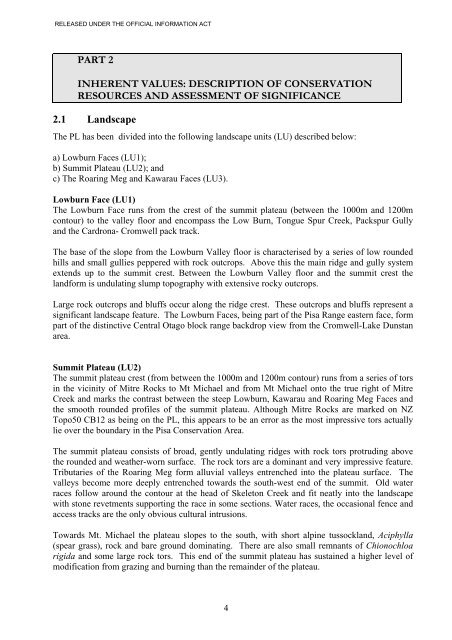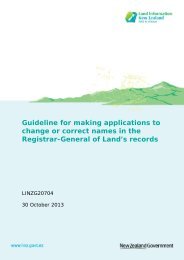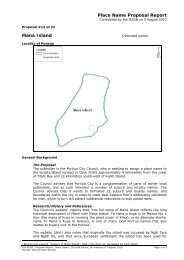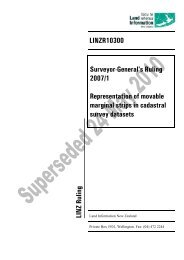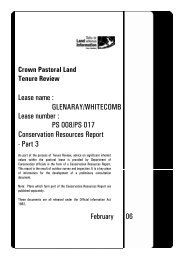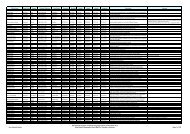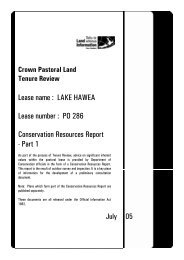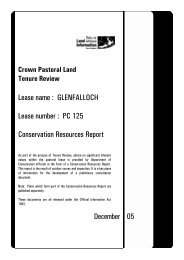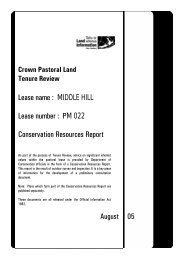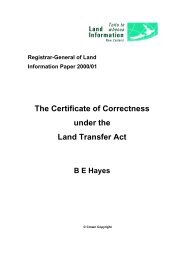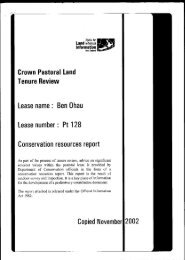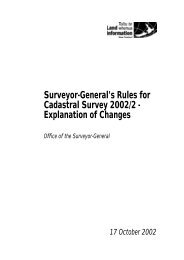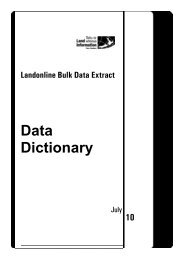Part 1 - Land Information New Zealand
Part 1 - Land Information New Zealand
Part 1 - Land Information New Zealand
Create successful ePaper yourself
Turn your PDF publications into a flip-book with our unique Google optimized e-Paper software.
RELEASED UNDER THE OFFICIAL INFORMATION ACT<br />
PART 2<br />
INHERENT VALUES: DESCRIPTION OF CONSERVATION<br />
RESOURCES AND ASSESSMENT OF SIGNIFICANCE<br />
2.1 <strong>Land</strong>scape<br />
The PL has been divided into the following landscape units (LU) described below:<br />
a) Lowburn Faces (LU1);<br />
b) Summit Plateau (LU2); and<br />
c) The Roaring Meg and Kawarau Faces (LU3).<br />
Lowburn Face (LU1)<br />
The Lowburn Face runs from the crest of the summit plateau (between the 1000m and 1200m<br />
contour) to the valley floor and encompass the Low Burn, Tongue Spur Creek, Packspur Gully<br />
and the Cardrona- Cromwell pack track.<br />
The base of the slope from the Lowburn Valley floor is characterised by a series of low rounded<br />
hills and small gullies peppered with rock outcrops. Above this the main ridge and gully system<br />
extends up to the summit crest. Between the Lowburn Valley floor and the summit crest the<br />
landform is undulating slump topography with extensive rocky outcrops.<br />
Large rock outcrops and bluffs occur along the ridge crest. These outcrops and bluffs represent a<br />
significant landscape feature. The Lowburn Faces, being part of the Pisa Range eastern face, form<br />
part of the distinctive Central Otago block range backdrop view from the Cromwell-Lake Dunstan<br />
area.<br />
Summit Plateau (LU2)<br />
The summit plateau crest (from between the 1000m and 1200m contour) runs from a series of tors<br />
in the vicinity of Mitre Rocks to Mt Michael and from Mt Michael onto the true right of Mitre<br />
Creek and marks the contrast between the steep Lowburn, Kawarau and Roaring Meg Faces and<br />
the smooth rounded profiles of the summit plateau. Although Mitre Rocks are marked on NZ<br />
Topo50 CB12 as being on the PL, this appears to be an error as the most impressive tors actually<br />
lie over the boundary in the Pisa Conservation Area.<br />
The summit plateau consists of broad, gently undulating ridges with rock tors protruding above<br />
the rounded and weather-worn surface. The rock tors are a dominant and very impressive feature.<br />
Tributaries of the Roaring Meg form alluvial valleys entrenched into the plateau surface. The<br />
valleys become more deeply entrenched towards the south-west end of the summit. Old water<br />
races follow around the contour at the head of Skeleton Creek and fit neatly into the landscape<br />
with stone revetments supporting the race in some sections. Water races, the occasional fence and<br />
access tracks are the only obvious cultural intrusions.<br />
Towards Mt. Michael the plateau slopes to the south, with short alpine tussockland, Aciphylla<br />
(spear grass), rock and bare ground dominating. There are also small remnants of Chionochloa<br />
rigida and some large rock tors. This end of the summit plateau has sustained a higher level of<br />
modification from grazing and burning than the remainder of the plateau.<br />
4


